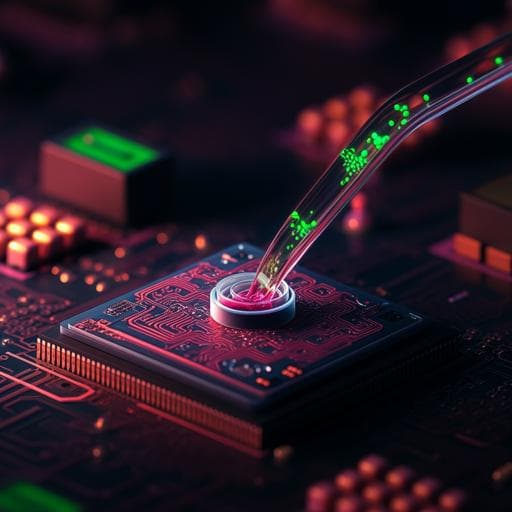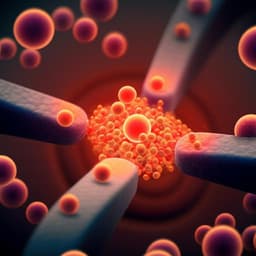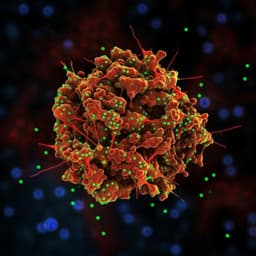
Engineering and Technology
Highly stable integration of graphene Hall sensors on a microfluidic platform for magnetic sensing in whole blood
N. Shah, V. Iyer, et al.
This paper presents innovative CMOS-compatible graphene Hall sensors integrated with PDMS microfluidics for magnetic sensing in blood. The developed graphene micro-Hall detectors demonstrate exceptional robustness and performance, paving the way for groundbreaking clinical applications, as validated by tests with magnetic beads by authors Nishal Shah, Vasant Iyer, Zhiping Zhang, Zhaoli Gao, Juhwan Park, Venkata Yelleswarapu, Firooz Aflatouni, A. T. Charlie Johnson, and David Issadore.
~3 min • Beginner • English
Introduction
The detection of rare cells (<10 cells/mL), including circulating tumor cells and pathogens, in accessible liquid biopsies such as blood or sputum holds significant promise for diagnostics. A successful strategy labels targeted cells with antibody-functionalized superparamagnetic nanoparticles (MNPs) and detects them by flowing the labeled cells over micrometer-scale magnetic field sensors. Key advantages are that biological fluids have negligible magnetic susceptibility, eliminating sample preparation and associated loss of rare cells, and that magnetic sensors can be miniaturized to match cell size and integrated without bulky optics. Micromagnetic sensors can interrogate individual cells to distinguish rare cells from unbound MNPs and nonspecifically labeled cells. Multiple modalities have been used for magnetic detection, including GMR, magnetic susceptometry, NMR, and Hall-effect sensors, with promising preclinical results.
Micro-Hall detectors (µHDs) are attractive for rare cell detection due to their sensitivity and linear response over large magnetic fields, enabling full magnetization of MNPs, which boosts signal. However, achieving high sensitivity often requires serial interrogation at single-cell volumes, limiting throughput, and the microscale channels needed are susceptible to clogging with whole blood. A potential solution is large arrays of µHDs to parallelize flow streams, increasing throughput and providing robustness to clogging. Such arrays require on-chip logic, triggering, multiplexing, and ADCs, pointing to CMOS integration. Conventional CMOS Hall sensors reside microns below the chip surface, reducing sensitivity because the demagnetization field decays as 1/d^3, and silicon’s sensitivity is lower than GMR and PHEMT/2DEG Hall sensors, which are harder to integrate with CMOS.
Two-dimensional materials (2DMs) offer high performance with simplified CMOS integration via post-fabrication transfer. Graphene, with mature wafer-scale synthesis/transfer and high room-temperature mobility, is an appealing Hall sensing material. Prior graphene Hall sensors have been hybridized with CMOS (graphene on IC, wire-bonded), but not used for in-flow magnetic sensing in biofluids. A major challenge is stability in ionic fluids and biofouling: thicker passivation improves stability but increases distance to targets, reducing sensitivity. Reported encapsulations include long-term hBN and PMMA passivation, but stability in complex biofluids has been uncertain. This work evaluates graphene as a CMOS-compatible magnetic sensor material by developing a graphene Hall sensor (µGS) integrated with microelectronics and PDMS microfluidics for detecting passing magnetic beads in complex biofluids, with passivation enabling robust, multi-hour operation in whole blood and proof-of-concept in-flow detection on a silicon substrate.
Literature Review
The paper situates its work within magnetic rare-cell detection methods. It notes prior successes of immunomagnetic labeling with MNPs and sensing via micrometer-scale magnetic sensors, highlighting minimal magnetic background in biofluids and scalability to single-cell volumes. It reviews microfluidic magnetic separation and several sensor modalities used for detection of targets: GMR sensors, magnetic susceptometry, NMR, and Hall-effect sensors. µHDs stand out for linearity over large fields, enabling full MNP magnetization and improved signal, unlike GMR’s narrow dynamic range. It discusses limitations of conventional CMOS Hall sensors (active layer depth reducing sensitivity due to 1/d^3 field decay, and lower sensitivity vs. GMR or 2DEG-based Hall sensors such as PHEMT) and integration challenges of higher-performance non-silicon sensors with standard CMOS. The authors point to two-dimensional materials, particularly graphene, as enabling high performance with post-fabrication transfer onto CMOS without high-temperature or bonding steps, citing prior 2DM–CMOS integrations for imaging and gas sensing. Stability/passivation of graphene Hall sensors is reviewed: long-term hBN encapsulation, PMMA-passivated graphene on CMOS (with untested biofluid stability), and the trade-off between passivation thickness and sensitivity. Table 1 compares best-reported Hall sensors across materials (Bi, Si, InSb, CVD graphene with passivation in this work, graphene with h-BN, InAs/GaSb, GaAs/AlGaAs III-V, MoS2), listing current-related sensitivity, bias, absolute sensitivity, minimum detectable field, frequency, and mobility, underscoring graphene’s competitive performance and CMOS compatibility.
Methodology
Device fabrication and integration:
- Graphene growth: Monolayer graphene grown by low-pressure CVD on copper foil (Alfa Aesar 46365) at 1020 °C for 20 min with 10 sccm CH4 and 80 sccm H2 at 50 mTorr.
- Transfer and electrodes: Graphene transferred by bubble transfer onto a silicon wafer with 280 nm thermal SiO2 (University Wafer 3333), with prefabricated Ti/Au electrodes (2 nm Ti, 40 nm Au; lift-off, e-beam evaporation, Lesker PVD).
- Patterning: Positive-resist photolithography and O2 plasma etch at 50 W for 30 s to define double-cross Hall bars (length 70 µm, Hall bar width 28 µm, arm width 8 µm). SEM confirmed intact graphene atop electrodes.
- Annealing: Post-patterning anneal at 225 °C for 1 h in H2/Ar (250 sccm H2, 1000 sccm Ar) to remove resist residues.
- Passivation: Encapsulation with 300 nm HSQ (XR-1541) spin coat, followed by 140 nm Si3N4 deposition via CVD (Oxford PlasmaLab 100). Thicknesses verified by ellipsometry (Filmetrics F40).
- Microfluidics: PDMS channels fabricated by soft lithography (SU8 2050 mold). Channel dimensions 50 µm wide × 50 µm tall with one inlet and one outlet. PDMS (10:1 elastomer:curing agent) baked at 65 °C for 2 h. PDMS and passivated chip surfaces activated in O2 plasma (50 W, 30 s; barrel asher, Anatech); alignment on mask aligner; irreversible bonding achieved. Tubing connected; flow driven by positive pressure. PDMS shrinkage (1.06–1.67%) under these conditions did not impair alignment of 33 µm-wide µGS array within the 50 µm channel.
- Magnetic bias: A 0.25-inch diameter NdFeB permanent magnet (K&J Magnetics D4C-N52) positioned directly beneath the sensing region to minimize bead loss and clogging from magnetophoretic edge effects.
Graphene and device characterization:
- AFM thickness: ~0.6 nm, consistent with monolayer graphene.
- Raman spectroscopy (532 nm): Prominent G (1580 cm⁻1) and 2D (2690 cm⁻1) peaks; no D peak (1350 cm⁻1); 2D/G ratio 2.20; 2D FWHM 29.78 cm⁻1, confirming high-quality monolayer graphene.
- Mobility measurement: Direct transconductance method with back-gate voltage sweep on 280 nm SiO2. Electron mobility after passivation averaged µ = 4600 ± 300 cm²V⁻1s⁻1 across 67 µGS devices; ~30% reduction post-passivation vs. pre-passivation, yet higher than silicon sensors. Mobility computed from gm = ∂I/∂VG = µ Cox (W/L) VDS, yielding µ = gm L/(Cox W VDS).
Magnetic sensing performance (dry conditions unless noted):
- Hall response: VH vs. B linear from −2 T to +2 T with absolute sensitivity Sa = 175 mV·T⁻1 (R² = 0.99997) at Ibias = 100 µA, giving current-related sensitivity SI = 175 V·A⁻1·T⁻1.
- Gate tunability: VH tunable with back-gate voltage; maximum response −229 mV at VG = 74 V. Notes that using thinner, higher-κ dielectrics (e.g., Al2O3, HfO2) could reduce required VG.
- Noise: FFT analyzer (Stanford Research SR770) used across 100 Hz–100 kHz. Minimum detectable field Bmin = 1.35 µT·Hz⁻1/2 at 3 kHz with Vbias = 10.3 V. 1/f noise characteristic extends to 100 kHz, with ~200 nT·Hz⁻1/2 at 100 kHz. Lock-in detection proposed to shift signal to higher frequencies for improved noise performance.
- Thermal noise limit estimate: With RµGS = 3.6 kΩ, T = 300 K, SI from measurements, and Ibias = 3 mA, Bmin,th ≈ √(4kTRµGS)/(SI Ibias) ≈ 12 nT·Hz⁻1/2.
Biofluid integration and stability testing:
- PDMS–graphene device operated with complex biofluids including human whole blood; passivation (HSQ/Si3N4) allowed robust operation over extended durations. Stability demonstrated for up to 39 h of continuous operation in human blood.
- In-flow detection assays performed in bovine serum albumin (BSA) and whole blood using magnetic agarose beads as controlled models for magnetically labeled cells. Sensor integrated beneath microfluidic channel with perpendicular magnetic field to detect demagnetization fields of passing beads.
Key Findings
- Developed CMOS-compatible, passivated graphene Hall sensors (µGS) integrated with PDMS microfluidics capable of magnetic sensing in complex biofluids, including whole blood.
- Demonstrated robust long-term operation: stable sensing for up to 39 h of continuous operation in human blood without fouling-induced failure.
- Achieved in-flow detection of magnetic agarose beads (cell mimics) in BSA and whole blood, validating feasibility for rare cell assays.
- Graphene quality and transport: monolayer confirmed by AFM (~0.6 nm) and Raman (no D peak, 2D/G = 2.20, 2D FWHM 29.78 cm⁻1). Average electron mobility after passivation: 4600 ± 300 cm²V⁻1s⁻1 across 67 devices; ~30% reduction from pre-passivation but still superior to silicon sensors.
- Magnetic sensitivity and linearity: Absolute sensitivity Sa = 175 mV·T⁻1 (R² = 0.99997) over −2 T to +2 T; current-related sensitivity SI = 175 V·A⁻1·T⁻1 at 100 µA bias. Gate-tunable response with maximum VH = −229 mV at VG = 74 V.
- Noise performance: Minimum detectable field Bmin = 1.35 µT·Hz⁻1/2 at 3 kHz with Vbias = 10.3 V; 1/f noise extends to 100 kHz (~200 nT·Hz⁻1/2 at 100 kHz). Estimated thermal noise floor ≈ 12 nT·Hz⁻1/2 at Ibias = 3 mA (RµGS = 3.6 kΩ).
- Integration practicality: PDMS microchannels (50 µm × 50 µm) aligned over 33 µm-wide µGS array; oxygen plasma bonding; permanent magnet (0.25-inch NdFeB) under sensing region minimized magnetophoretic bead losses and clogging.
- Comparative context (Table 1): Paper reports CVD graphene + passivation with SI ≈ 484 V·A⁻1·T⁻1, Sa ≈ 484 mV·T⁻1 at 1 mA, and Bmin ≈ 4000 nT·Hz⁻1/2 at 3 kHz, situating performance among best-reported Hall sensors and underscoring graphene’s competitiveness and CMOS compatibility.
Discussion
The work addresses key barriers to translating micro-Hall detection to clinical contexts: stability in complex biofluids, compatibility with CMOS, and integration with microfluidics. By employing HSQ/Si3N4 passivation on transferred CVD graphene, the authors maintain high mobility and sensitivity while ensuring multi-hour stability in whole blood, mitigating biofouling and ionic interference. The microfluidic architecture, aligned to single-cell-scale channels, enables detection of magnetically labeled targets while minimizing background signals from unbound MNPs. Demonstrated linear response across ±2 T allows full magnetization of labels, maximizing signal compared with sensors constrained to narrow dynamic ranges.
The noise analysis indicates that although 1/f noise dominates up to high frequencies in the current implementation, lock-in detection and CMOS-integrated readout can shift signal content to frequencies where lower noise floors are achievable, approaching thermal noise limits. The measured Bmin (1.35 µT·Hz⁻1/2 at 3 kHz) demonstrates feasibility for bead/cell detection in flow; the estimated thermal limit (≈12 nT·Hz⁻1/2) suggests substantial headroom with optimized biasing and readout. Gate tunability offers further adaptability, and future substitution of the 280 nm SiO2 gate dielectric with thinner high-κ materials could reduce required gate voltages for on-chip operation.
Overall, the results validate that graphene Hall elements can be integrated with soft-lithographic PDMS microfluidics and are promising for post-fabrication integration on CMOS ICs. This paves the way for massively parallel µHD arrays with on-chip multiplexing and digitization, addressing throughput limitations and providing robustness against individual channel clogs for rare-cell analyses.
Conclusion
This study demonstrates a CMOS-compatible, passivated graphene Hall sensor platform integrated with PDMS microfluidics for magnetic detection in complex biofluids, including whole blood. The devices exhibit high-quality monolayer graphene, maintain relatively high mobility after passivation, provide linear and tunable magnetic responses across a wide field range, and support stable operation for at least 39 h in blood. In-flow detection of magnetic agarose beads validates performance in conditions relevant to rare-cell assays.
Main contributions:
- A fabrication workflow for CVD graphene µGSs with HSQ/Si3N4 passivation compatible with microfluidic operation in whole blood.
- Quantified sensitivity and noise performance, including gate tunability and noise-floor estimates, establishing feasibility and indicating routes to further improvements.
- Integration strategy (permanent magnet bias, PDMS alignment/bonding) supporting robust in-flow sensing.
Future work:
- Monolithic or post-fabrication integration of graphene µGS arrays onto custom CMOS ICs with on-chip logic, multiplexing, and ADCs for high-throughput, parallelized detection.
- Optimization of gate dielectrics (e.g., thin high-κ layers) to reduce operating voltages and improve tunability.
- Further passivation and surface engineering to extend operational lifetimes and minimize biofouling.
- Transition from bead models to immunomagnetically labeled cells in clinical samples and validation in larger cohorts.
- Advanced readout (lock-in at higher frequencies) to suppress 1/f noise and approach thermal noise limits.
Limitations
- The demonstrated system is a proof-of-concept on a silicon substrate; full integration with a custom CMOS chip for in-flow magnetic sensing has not yet been realized in this report.
- Stability was shown for up to 39 h; longer-term continuous operation and repeated use cycles in whole blood were not reported here.
- Performance validation used magnetic agarose beads as cell surrogates; results on immunomagnetically labeled biological cells in clinical samples remain to be demonstrated.
- High back-gate voltages (e.g., VG ≈ 74 V) were used due to the 280 nm SiO2 dielectric; implementation with thinner high-κ dielectrics is needed for practical low-voltage operation.
- Noise is dominated by 1/f behavior up to high frequencies (~100 kHz), and the measured Bmin (1.35 µT·Hz⁻1/2 at 3 kHz) is above the estimated thermal limit, indicating room for readout and bias optimization (e.g., lock-in techniques, higher bias currents within thermal constraints).
- Trade-off between passivation thickness (stability) and sensor–target distance (sensitivity) persists; optimization may be needed for different biofluids and target sizes.
Related Publications
Explore these studies to deepen your understanding of the subject.







